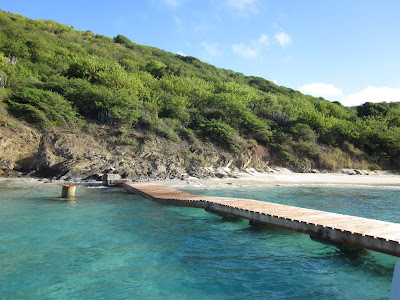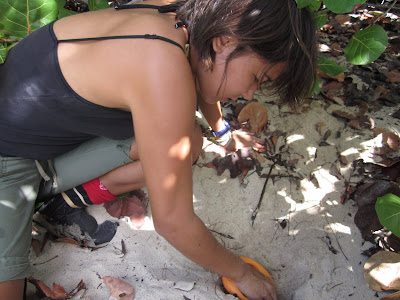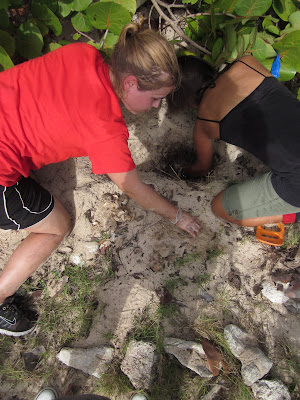1)I've learned what the saying "wherever you go, there you are" really means:
To me it means being comfortable being by myself, learning to trust my gut and and to rely on my judgment to make the most of the time I've been here. I've found that in being more centered within myself I've established more meaningful relationships with the people I've met here, and that while I'm sad to leave, I am also very excited to see my friends and family back home- who are a big part of who I am.
It's been some time since Holly Nelson mentioned St Croix to my class and during a presentation in our junior year. Since that time I've gotten to know the place on several different levels- there was the GIS presentation by Rutgers students who'd never stepped foot on the island. Then the google searches before my first visit. Next our 5 day visit to the island with a packed itinerary of people to talk to and places to see. And then a semester of studying and mapping from afar, and reflecting on each moment from that trip. And now there's now. Each of these forms of interaction led to different levels of understanding of place. Some of the strangest moments to me after being on island for 5 weeks is when I come across a place that I visited while here before. Despite how eager I was to understand St. Croix at the time, I am always struck by my impression of the place back in August 2010, and my knowledge of it now. And yet I have only been here a few weeks- imagine the richness that would exist in my mind were I hear longer! The learning curve that there is in learning a place is absolutely fascinating, but it is also somewhat frightening because I now realize how much effort is required to get far enough along that curve to truly understand the place in which we design. And if we do not understand the place, how can we design spaces that work within the culture they reside?

3) I've learned to be trans-disciplinary:
David Goldstein and I discussed this term a little bit while I was here- specifically what the difference is between inter-disciplinary and trans-disciplinary. Inter-disciplinarity has been preached to me throughout my undergrad education. What I've realized here in St. Croix is that Landscape Architecture IS in and of itself inter-disciplinary already- the skill set we posses are those of an environmentalist, artist, engineer, architect, graphic designer, urban planner and more all at once. This is why it is sometimes difficult to explain what it is we do to the public- because we CAN do a lot and still call ourselves Landscape Architects. The challenge therefore isn't to be INTER-disciplinary- we should already be that- but to work TRANS-disciplinarily- or across the disciplines with skill sets and focuses very different from ours. This is the challenge: to work with the psychologists, anthropologists, doctors and biologists and collaborate with them just as we do with engineers and architects.
While here I've seen this happening, and participated in it myself. My partners in this experience were anthropologists, biologists, artists, hotel owners, librarians, students, science professors and more. On Monday I attended part of the EPSCoR conference, and was thrilled to learn an incredible amount about marine life- information that is applicable to the work of a Landscape Architect.
4)I've discovered new interests- both personally and professionally:
Getting my open water diver certification was one of the highlights of this trip. As a landscape architect I felt it was really important to see for myself the benthic landscape that terrestrial landuse affects. The excitement of swimming with a school of bright blue fish or seeing a green sea turtle in the surf if a feeling I want my children and grandchildren to experience, and the realization that I can contribute to the protection of reef ecosystems is empowering.
I also did not realize when I agreed to come here that David Goldstein (the Park Interpreter) studied a topic that was so closely related to my own interests. As an anthropologist he has studied indigenous agriculture and the way that people have grow food and sustained themselves for centuries. Our conversations in the car on the way to and from work have been inspiring and stimulating and has given me fresh ideas for my application to the Fulbright.
I rented a car for my last few days on island, and had the chance to drive around to all the places that I had wanted to visit but didn't have access to beforehand. Yesterday morning, with just a few hours before I had to board a plane, I drove my little rental car into the rainforest to visit Nate Olive and the Sustainable Farm Institute. I had forgotten how off roads it was, and with all the rain the drive was slick with mud- I prayed the whole time that I wouldn't end up over the edge and tumbling down the mountain. I'd been reluctant to admit to myself that I was really leaving St. Croix because I hoped that I'd be back, but I didn't know when, or in what capacity. In the short time I spent at the farm I realized something: I will most definitely be back in St. Croix- we have unfinished business. The past five weeks have really given me clarity on the direction I'd like to take Landscape Architecture, and the ideas and practices of the farm are so wrapped up in all that I've been exploring that I just know I'll be back before too long.
So for now St. Croix this departure isn't a goodbye- it's a see ya later!!!
















































